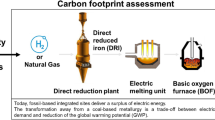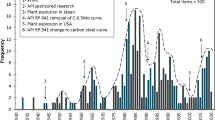Abstract
JSW Steel Ltd. supplies hydrogen-sensitive rail steels blooms for the manufacture of steel rails for Euro-rail application through AFERPI, Lucchini. The hydrogen distribution in the production of two high-carbon near-eutectoid rail steel grades VAR89S (typically, 0.70%C–0.3%Si–1.1%Mn–0.015%S) and VAR101 (typically, 0.80%C–0.42%Si–1.01%Mn–0.65%Cr–0.005%S) has been examined from the steel making stage to the as-cast blooms. In the steel grade VAR89S, the hydrogen distribution has been examined in the hot-rolled steel rails at different locations. The steel making involves primary steel making using energy optimizing furnace, ladle furnace followed by vacuum degassing. The hydrogen content before secondary steel making varies between 3 and 5.5 ppm H, which decreases to less than 1.5 ppm H after vacuum degassing. The steel picks up hydrogen, when transferred to tundish to a value, less than 2.5 ppm, associated with moisture in spray mass and tundish compound. On solidification in continuous casting, the hydrogen level decreases to less than 1.6 ppm H, which is associated with lowering of hydrogen solubility associated phase transformation of molten steel to solid. When the bloom is converted to steel rails, the hydrogen level further decreases due to the increased surface area-to-volume ratio. The final hydrogen levels in steel rails are < 1.6 ppm H, which is safe enough against defects such as shatter crack or Tache Ovales in steel rails.










Similar content being viewed by others
References
Mishra N S, Ramaswamy Y, and Mishra S, Sadhana9 (1986) 345.
Bold P E, in International Conference on Rail Quality and Maintenance for Modern Railway Operation, Delft, (eds) Frederick C O, Kalker J J, Cannon D F, and Orringer O, Kluwer Academic Publishers (1992) p 397.
Li P, Xian A, Wang Y, Chen R, and Mei D, Acta Metall Sin (Eng) Ser A, 6 (1993) 415.
Agarwal A, and Rai A K, in Rail Steel, Indian Railway Institute of Civil Engineering, Pune (2007), p 26.
Rail Defects Handbook, TMC 226, Engineering manual Track, Ver 1.2, NSW Rail Transport Corporation, Chapter-6 (2012) p 49.
Cabrera-Marrero J M, Coarreno-Galindo V R, Morales R D, and Chavez-Alcala F, ISIJ Int38 (1998) 812.
Thapliyal V, Inclusion engineering in Mn-Si de-oxidized steel for thin-strip casting, Doctoral Dissertations, Department: Materials Science and Engineering, Missouri University Of Science and Technology (2015), p 28. https://scholarsmine.mst.edu/cgi/viewcontent.cgi?article=3399&context=doctoral_dissertations.
Shekari E, Shishesaz M R, Rashed Gh., Farzam M, and Khayer E, Iran J Oil Gas Sci Technol2 (2013) 65.
Fruehan R J, in Fundamentals of Iron and Steel Making, 11th ed, (eds) Turkdogan E T, Freuhan R J, AISE Foundation, Pittsburgh, Chapter-2, The AISE Steel Foundation, Pittsburgh (1998) p 141.
Niyogi A, IIM Metal News12 (2009) 17.
Ravichandar D, Balusamy T, Gobinath R, and Balachandran G, Trans Indian Inst Met71 (2018) 2505.
Braganca S R, Hohemberger J M, Vicenzi J, Marques C M, Basegio T, Lima A N C, and Bergmann C P, Steel Res Int77 (2006) 400 https://doi.org/10.1002/srin.200606405.
Chen C Y, and Lin K J, China Steel Tech Rep24 (2011) 7.
De Bruycker E, De Vroey S, Huysmans S, and Stubbe J M P, Mater Test56 (2014) 439.
Key to Metals in Hydrogen in Steel. https://www.totalmateria.com/page.aspx?ID=CheckArticle&site=kts&NM=206.
Sigworth G K, and Elliott J F, Metal Sci, 8 (1974) 298.
Pawłowski B, JAMME49 (2011) 332.
Ghosh A, Sadhana26 (2001) 5.
Ravichandar D, Balusamy T, and Balachandran G, Trans IIM (2019) https://doi.org/10.1007/s12666-019-01747-4.
Luu W C, and Wu J K, Mater Lett24 (1995) 175.
To Y I, Yonezawa N, and Matsubara K, Trans ISIJ20 (1988) 301.
Heller E, Weber L, Hammerschmid P, and Schwitzer R, Sathl Eisen92 (1972) 934.
Acknowledgements
The authors gratefully acknowledge the support rendered by Mrs Alessandra Merigo and Mr T Mohan Babu of AFERPI, Piombino, Italy, for sharing some of the process and product information of rails made using steel supplied by JSW Steel, Salem Unit. The authors thank the assistance rendered by Mr M Vidhyasagar of R&D, Mr S Selvakumar and Mr G Tamilselvan of QAD at JSW Steel Limited, Salem works.
Author information
Authors and Affiliations
Corresponding author
Additional information
Publisher's Note
Springer Nature remains neutral with regard to jurisdictional claims in published maps and institutional affiliations.
Rights and permissions
About this article
Cite this article
Ravichandar, D., Balusamy, T. & Balachandran, G. Behaviour of Hydrogen During the Manufacture of Rail Steels. Trans Indian Inst Met 72, 3285–3294 (2019). https://doi.org/10.1007/s12666-019-01798-7
Received:
Accepted:
Published:
Issue Date:
DOI: https://doi.org/10.1007/s12666-019-01798-7




